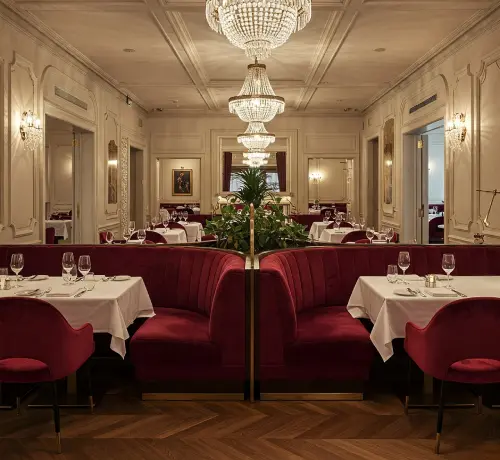Introduction:
In the competitive culinary landscape, a memorable dining experience extends far beyond the exquisite flavors on the plate. It encompasses the entire ambiance, a carefully orchestrated symphony of sensory details that tantalize and delight. Designing a fine-dining restaurant is therefore an art form, a delicate balance of aesthetics and functionality where every element, from the subtle glow of the lighting to the plushness of the seating, plays a crucial role in shaping customer perception and solidifying brand identity. Join us as we explore the nuances of commercial interior design through the lens of our recent fine-dining project, where we meticulously crafted a space to elevate the dining experience to an unforgettable level.
1. Setting the Stage: The Power of Thematic Lighting
Lighting in a fine-dining setting is more than just illumination; it's a narrative tool that sets the mood and guides the eye. For our project, we envisioned an atmosphere of sophisticated intimacy. We moved beyond harsh overhead lights, opting for a layered approach:
- Ambient Warmth: Soft, diffused lighting from strategically placed sconces and recessed fixtures washes the space in a gentle glow, creating a welcoming and relaxed environment.
- Focused Table Lighting: Individual pendant lights or adjustable spotlights grace each table, casting a warm pool of light that highlights the culinary artistry and fosters a sense of privacy for diners.
- Accent Lighting: Carefully positioned spotlights draw attention to architectural features, artwork, and decorative elements, adding depth and visual interest to the overall design.
- Dimmability: The ability to adjust lighting levels throughout the evening allows for a seamless transition from the brighter ambiance of early service to a more intimate setting as the night progresses.
The result is a carefully curated interplay of light and shadow that enhances the dining experience without being intrusive, allowing guests to feel both seen and secluded.
2. Indulgent Comfort: The Importance of Plush Seating
In a fine-dining establishment, guests are invited to linger and savor the experience. Comfortable seating is therefore paramount to ensuring their enjoyment. For our design, we prioritized both aesthetics and ergonomics:
- Luxurious Materials: We selected rich velvet and supple leather upholstery in deep, inviting tones, adding a touch of opulence and tactile pleasure.
- Ergonomic Design: Chairs and banquettes were chosen for their supportive structure and ample cushioning, allowing guests to relax comfortably for extended periods.
- Variety of Seating Options: We incorporated a mix of intimate two-top tables with individual armchairs, larger round tables with banquette seating for groups, and strategically placed lounge areas for pre- or post-dinner drinks.
- Spatial Arrangement: Careful consideration was given to the spacing between tables, ensuring privacy and ease of movement for both guests and staff.
The plush seating not only enhances the physical comfort but also contributes to the overall feeling of indulgence and sophistication that defines the fine-dining experience.
3. The Sound of Serenity: Acoustic-Enhanced Ceilings
While visual and tactile elements are crucial, the auditory experience is equally important in creating a refined atmosphere. Noise pollution can detract significantly from a fine-dining setting. To address this, we incorporated acoustic-enhanced ceiling solutions:
- Acoustic Panels: Discreetly integrated panels with sound-absorbing properties were installed to minimize echo and reverberation, creating a more intimate and conversational environment.
- Suspended Acoustic Features: Decorative ceiling elements with acoustic backing not only add visual interest but also help to diffuse sound waves.
- Strategic Material Selection: We opted for materials with inherent sound-dampening qualities, such as certain types of fabrics and wall coverings.
The result is a dining space where conversations flow easily, and the gentle clinking of silverware and soft background music create a harmonious and sophisticated soundscape, free from distracting noise.
4. Weaving the Narrative: Design Choices and Brand Identity
Every design choice in a fine-dining restaurant should contribute to the overarching brand identity. For our project, we aimed to evoke a sense of timeless elegance with a contemporary edge. This was achieved through:
- Color Palette: A sophisticated palette of deep jewel tones, accented by metallics and warm neutrals, creates a sense of luxury and refinement.
- Material Selection: The use of high-quality natural materials like wood, stone, and rich fabrics reinforces the premium nature of the establishment.
- Art and Décor: Carefully curated artwork and decorative objects reflect the restaurant's culinary philosophy and target audience.
- Attention to Detail: From the elegant tableware to the thoughtfully designed menus, every detail reinforces the brand's commitment to excellence.
The cohesive design narrative ensures that every aspect of the restaurant experience reinforces the brand's identity and creates a lasting impression on guests.
Conclusion:
Designing a fine-dining restaurant is a meticulous process that requires a deep understanding of both aesthetic principles and the nuances of the hospitality industry. By carefully considering elements like thematic lighting, plush seating, and acoustic-enhanced ceilings, and ensuring that every design choice aligns with the brand's identity, we can create commercial spaces that not only meet the functional needs of the establishment but also elevate the customer experience to an art form. Our recent project stands as a testament to the power of thoughtful design in crafting an unforgettable and truly exceptional fine-dining destination.


